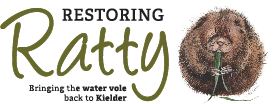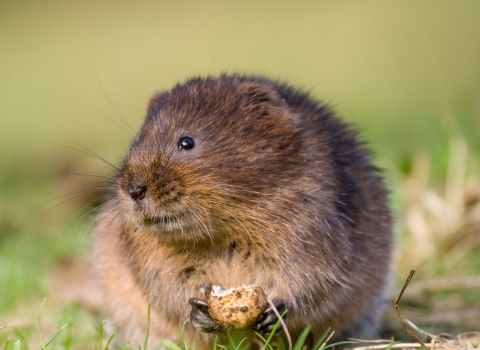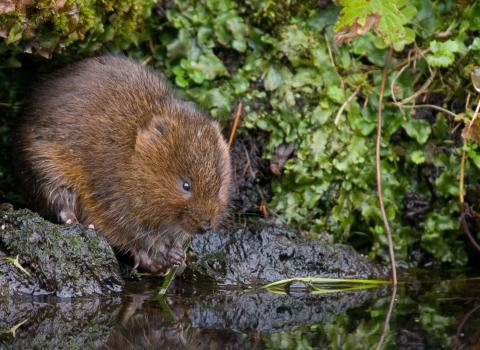
Bringing the water vole back to Kielder
The water vole - made famous through the 'Ratty' character in the Wind in the Willows children's story - was once a familiar sight on our local waterways but sadly numbers have declined dramatically in recent years. However, thanks to funding from the The National Lottery Heritage Fund and the support of partners in Forestry England and Tyne Rivers Trust, NWT was able to restore water vole populations into the Kielder catchment of the north Tyne. We are currently monitoring this population and allowing it to spread throughout the catchment and surrounding areas.
What have we done?
Between 2016 and 2022, the project reintroduced around 2,200 water voles into Kielder Water and Forest Park to establish a source population of water voles which could then expand into the wider mink monitoring area. To achieve this, water voles were collected from donor sites in the North Pennines, Yorkshire and Trossachs where suitable water vole populations currently exist. Through captive breeding, numbers were increased to ensure sufficient voles were available for reintroduction. Donor animals were collected during autumn 2016, with breeding taking place from spring 2017 and then the first release took place in June 2017. Since then, there have been a further eleven releases, with the most recent and final release in August 2022. To date we have released 2,039 water voles into Kielder Water and Forest Park.
Throughout this project, NWT volunteers and other partners have been undertaking the task of monitoring for the presence of mink in and around the Kielder Water Forest Park. This indicated that the area was virtually mink free and the environment was suitable for the reintroduction of water voles. We cannot however rest on our laurels as mink are always on the fringes of the area and could surface at any time, and as such, monitoring will continue throughout the remainder of the project. The project has also allowed the team to install a series of interpretation at Kielder Castle and Kielder campsite.
Videos
The Ratty team has documented the progress from capture to release and the following clips show the process and the frustrations and joy of working with wildlife!
Part 1
The video below was filmed as we captured water voles in the North Pennines and shows the process and the frustrations and joy of working with wildlife!
Part 2
The capture voles are transferred down to Devon where they are over wintered and bred in specialist facilities. The breeding will carry on throughout the project to allow a genetically diverse supply of voles to be released into Kielder.
Part 3
The big release! In June 2016 we released 320 voles into the area north of Kielder Village. This process took over a week and a lot of hard work by our brilliant volunteers, staff and project partners. The video below shows the process. A further release of 270 water voles took place in August 2017, and then subsequent releases were made in June 2018 and August 2018.
Why bring back the water vole?
This project will reintroduce an iconic British species, thought to be the UK’s fastest declining mammal, to Kielder Water and Forest Park. Habitat loss, inappropriate wetland management and, principally, the introduction of the North American mink (Neovison vison) have all contributed to huge and continued water vole population losses since the 1960s. Populations fell by over 90% in the 1990s alone. The species has disappeared from 94% of sites where it was once prevalent. Kielder once had a thriving population and local residents can remember seeing water voles in the past.
How can you help?
We continue to monitor for mink and water voles in the Kielder area to ensure that the population can thrive. If you see signs of water voles or mink in Kielder or anywhere in Northumberland please let us know. Our long term aim is to allow water voles to thrive all over Northumberland and sightings will allow us to better understand the current situation.
Engaging with local schools
Of all the staff and volunteers involved in our water vole releases, probably the most excited project 'assistants' were 55 pupils from two schools (Terrington Hall School in North Yorkshire and Bellingham Middle School) who had the experience of a lifetime when they were invited to roll up their sleeves and help the project team with the releases. Read more about the work undertaken by the schools here.
20 pupils from the Bellingham school were the envy of their classmates when they were invited to assist with the release and filming of water voles into the waterways of Kielder. Check out the following short film, From The Mouths of Kids, produced by local filmmaker Alan Fentiman, to celebrate the first year of the Restoring Ratty Schools Partnership Project.

Tom Marshall
Donate to water voles
Although our Restoring Ratty project has ended, you can still donate to continue our water vole work
Keep in touch
If you would like more information about the project, please contact Graham Holyoak on (01434) 250 898 or email restoringratty@northwt.org.uk.
Partners



Funders

Restoring Ratty has been supported by a grant from The National Lottery Heritage Fund. Thanks to National Lottery players, we have been able to start work on the process to reintroduce Water Voles into Kielder. (www.heritagefund.org.uk)


